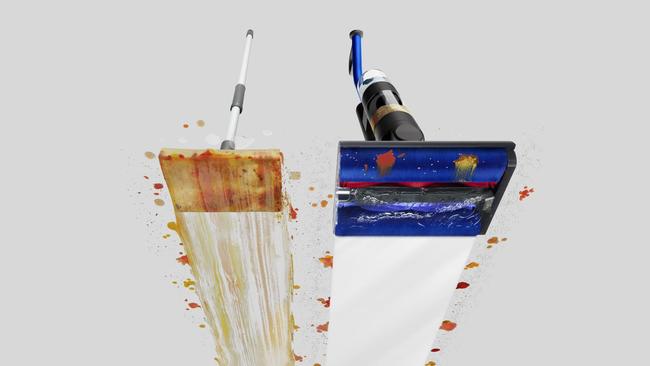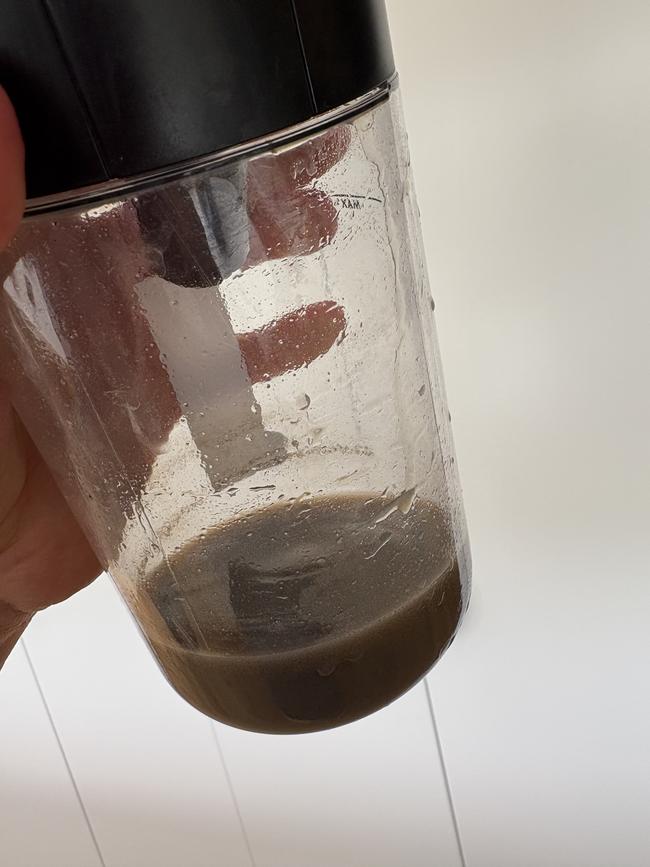Is Dyson’s new $1000 WashG1 mop worth it?
The British consumer electronics giant has gone full circle with the release of the WashG1 – but is it enough to convince this tech editor to stop using a mop, bucket and broom?

Business
Don't miss out on the headlines from Business. Followed categories will be added to My News.
Dyson has got back to basics with the launch of its latest product, aiming to solve a common problem when cleaning floors.
The British consumer electronics giant is best known for reinventing the vacuums with its cyclonic technology, which it then took to supersonic hair dryers and headphones. Now it’s gone full circle to disrupt the humble mop, with the release of the WashG1.
This is a mop that costs almost $1000 - putting it alongside its high-end vacuums. It aims to save a user time by vacuuming and mopping at the same time. James Dyson says the product makes for a “much more enjoyable and more effective way of cleaning hard floors”.
So after several months after trying out this piece of kit, does it live up to its claims?

Pros
Easy to use and maintain
Provides an effective clean.
Good battery life
Cons
Dust tray is a little small
Is hard to clean under tight spaces like beds and couches
The problem

I tried a lot of household gadgets that are supposed to make cleaning easier and earlier this year, I snapped. My pantry had become an archaeological dig, of sorts, representing used then discarded appliances, which I ended up spending more time cleaning and disassembling - and then trying to put back together again - that their intended purpose.
I’ve tried robotic vacuum mops - which worked well initially - but within mere months of use ended up disappointing, creating more mess than cleanliness. I’ve tried an array of stick vacs - including Miele’s HX1 - that lost suction and ended up creating somewhat of a jigsaw puzzle as I took the thing apart to find a blockage. Then there was the Karcher FC 5 - a product similar to Dyson’s WashG1 - which proved water and electricity didn’t mix.
So I went back to basics myself, using a 600mm orange Oates dust mop that once belonged to my mother-in-law. It worked like a dream, allowing me to clean under beds and couches with ease. My only complaint was a little squeak at its base, which I fixed with WD-40. Bliss. I used an old mop to swab the decks afterwards. Low-tech but it worked - every time. So Dyson has a tough mission to sway me back to electronic cleaning.
Dyson’s pitch
Before using the WashG1, Dyson told me I’d be surprised at the amount of dirt that’s on my floors, even if they look clean.

It said the WashG1removed wet spills, stains and dry dirt simultaneously, using more than two dozen pulse water jets backed by two counter directional rollers. It separates dirty water from clean water in the cleaning head, with the used water immediately being directed into a removable - and see-through - tank, which would leave me grossed out. It says this means the WashG1 removes mess rather than just spreading it.
Indeed, the used water in the tank was filthier than any I had seen in my old mop bucket, resembling a strong long-black.
Ease of use
I was impressed at the level of clean after a few weeks of use. My floors where glistening and it was easy to use and maybe, as James Dyson says, enjoyable. The rollers pull the mob along making it feel like it also has grunt.
But past experience tells me that as weeks turn into months, my glee will turn to disappointment. Surprisingly, this has not been the case with the WashG1.

It has a built-in screen that alerts you whether the mop needs urgent maintenance, and shows you an animation of how to fix the problem. Need to change the dust tray? It stops working and tells you to do it. Need to clean the rollers? The same thing happens. There is no guesswork or reaching for the manual, it tells you how to do it.
There are times when the tech doesn’t work exactly but - just like wringing out a mop - if you become routined it can overcome this problem. For example if you clean the dust tray at the end of each use, it doesn’t get blocked and leak dirty water over the floors. It’s a pretty simple thing to do. The same with the rollers - clean them once a week and you’ll get no build up or problems. And the Dyson animation makes this easy.
At first, I thought the battery life seemed a bit short - up to 35 minutes or 290sqm coverage - but I was able to clean my top floor: three bedrooms, a lounge, kitchen, halfway, bathroom, en-suite and laundry - on one charge.
Verdict
Dyson has achieved its aim in making a posh yet useful mop. Can it be perfected? Sure. The dust tray could be made bigger, given it can fill up quickly. But Dyson makes it easier to remove than the bin on it V10, which I found would sometimes stick a bit. There is also no filter washing routine - with 24-hour drying time like the V10 - which used to frustrate me. The rollers could also be smaller so it could fit under couches. But I suspect this would compromise the performance of the device and make cleaning a less than enjoyable experience.
Originally published as Is Dyson’s new $1000 WashG1 mop worth it?



